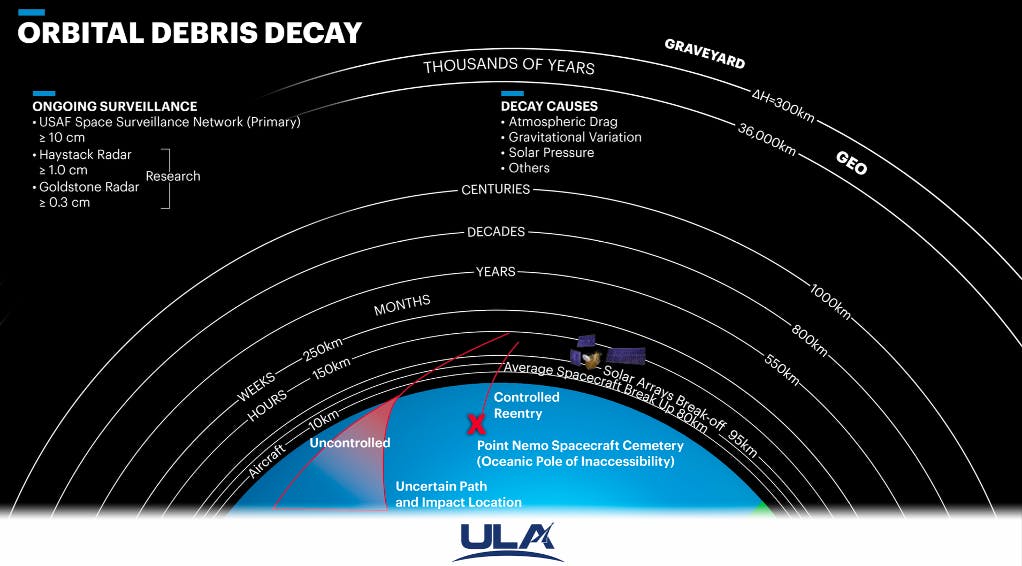There are already about half a million objects the size of a cigarette pack in Earth’s orbit, and soon there will be no room to move. Many people have a general idea of what this threatens, but not everyone appreciates the scale of the problem. Especially considering that the debris is moving at an average speed 10 times faster than the initial velocity of a bullet fired from a CZ Bren 2. Below is a summary of the current situation in space, several possible solutions to the problem, and a brief description of the methods that are beginning to be discussed in scientific circles.
What is space debris?
Space debris is man-made objects that are in orbit but have no practical significance. These are mainly devices that have reached the end of their active life — they have been damaged in an accident or have simply reached the end of their service life:
- upper stage boosters of launch vehicles;
- structural elements of rocket and space technology;
- parts and debris resulting from accidents;
- lost elements, such as thermal insulation tiles;
- particles of fuel, paint, and cladding.
According to modern space law, the country that launched an object into space must remove it after the end of its service life. But so far, this is only theory. In practice, the unlimited spread of space debris could jeopardize flight programs.
What is the danger of space debris?
The first problem is speed. The largest artificial object in Earth’s orbit is the ISS. Let’s take its orbit for our calculations — 390 km above the planet’s surface. We know that the ISS makes one complete revolution around the Earth in 1.5 hours. From this, it is easy to calculate the linear speed of movement in orbit — 28,000 km/h. This is 10 times faster than a 7.62×39 bullet fired from an CZ Bren 2.
Imagine what would happen if a bag of trash hit your head at that speed? And that’s not the maximum speed. Many satellites fly much faster.
The second problem is the amount of space debris.
The image below shows the results of a simulation from stuffin.space, which clearly demonstrates man-made objects in near-Earth orbit: from 100 to 1,000 km above the Earth’s surface. Almost all of it is space debris. There is information about each object.
The large red circle is the popular geostationary orbit, where telecommunications satellites are usually located, which always “hang” in one spot for an observer on Earth.
Classification of debris
Space debris is classified by size.
Small space debris is objects smaller than 1 cm. According to the most optimistic estimates, there are about 10 million such objects. Pessimistic estimates put the number at around 20 million.
These millions of particles cannot be tracked from Earth. Their flight is unpredictable.
Imagine that such a “bullet” hits your spacecraft. It will probably pierce it through. Most likely, the spacecraft will remain functional, but this is serious damage that could cause some of the onboard electronics to fail.
The second group is medium-sized space debris. These are objects with a maximum cross-sectional diameter of 1 to 10 cm. Although there are significantly fewer of them — about 500,000 units — they are much more dangerous. A collision between any satellite and such an object will cause serious damage. Most likely, the device will lose functionality, and in addition, small fragments of new space debris will be formed.
The advantage is that we can track medium-sized objects. If the automated warning system for dangerous situations in near-Earth space (ASPOS OKP) detects that an object is flying towards the ISS, the latter’s orbit is adjusted — the station is raised or lowered to avoid a collision.
The smallest and most dangerous group of objects is large space debris. This includes anything with a cross-sectional diameter greater than 10 cm. There are about 21,000 such objects. These are spacecraft and their large debris. A collision with such an object is similar to a car accident at a speed of 28,000 km/h. Nothing will remain of the spacecraft involved in such a collision. Moreover, the destruction will create a large amount of small space debris that will move along unpredictable trajectories.
How quickly does debris accumulate?
More than 25,000 objects larger than 10 cm are known to exist. The estimated population of particles between 1 and 10 cm in diameter is approximately 500,000. The number of particles larger than 1 mm exceeds 100 million. As of January 2022, the amount of material orbiting the Earth exceeded 9,000 metric tons.
Here’s how their numbers have grown since 1961:
In this graph, two jumps are visible on the “total objects” line, labeled “Fengyun Anti-satellite Test” and “Cosmos-Iridium,” in 2007 and 2009, respectively. Now I will explain where they came from.
In 2007, China tested its satellite interception technology by firing an anti-satellite missile at the first in a series of its own spacecraft, Fengyun 1C. By that time, the spacecraft was no longer functioning and was considered space debris. The missile destroyed it, exploding it into nearly 2,500 pieces. The result of that collision is shown in the slide:
No other spacecraft were hit. However, communication with a couple of satellites was lost, and many assume that they were disabled as a result of a collision with the debris of Fengyun 1C.
The second jump occurred in 2009. Over Russian territory, the American telecommunications satellite Iridium 33, which was operational at the time, collided with the Russian satellite Kosmos 2251, which was no longer operational. The convergence of the devices was known in advance, but Kosmos was already out of order, and Iridium had no means of control, so the collision could not be prevented.
This was the first known accident involving two artificial objects in space. As a result, about 3,000 pieces of debris were formed. The figure shows a model of their distribution around the Earth:
Kessler syndrome
American astroengineer Donald Kessler was the first to describe the phenomenon of the chaotic increase in the number of man-made objects in Earth’s orbit. In his opinion, this growth will lead to a chain reaction that will make the proliferation of space debris uncontrollable.
This effect is well illustrated in the movie Gravity, where a single collision triggers a cascade effect. Currently, space debris objects are in orbit like time bombs. Sooner or later, any of them could detonate.
Solving the problem of space debris
There are already a number of proposals for combating space debris, ranging from radical ones, such as completely abandoning space flights for several decades while waiting for near-Earth space to clean itself up, to entirely feasible ones.
There is even a classification for removal methods. Let’s talk about each of these groups.
Passive removal methods
This group of methods involves using the natural environment (what is around us) without artificial influences.
Solar sail
A solar sail (similar to a conventional sail on a ship) collects the sun’s energy to slow down an object. As it slows down, its orbit begins to decrease, eventually entering a re-entry orbit. The object then safely falls to Earth, burning up in the upper layers of the atmosphere.
The main drawback of a solar sail is its size. For the sail to work effectively, its area must be comparable to a small football field. In conditions of constant “bombardment” by small space debris in orbit, it will be difficult to deploy such a structure and keep it operational.
In addition, the method is difficult to use on spacecraft that have already been launched. It is not yet clear how to install a solar sail on them, unfold it, and orient it to achieve the desired effect.
Atmospheric drag
This method is based on the same sail effect, but in the Earth’s atmosphere.
At an orbit of 500 km, the influence of the atmosphere is still noticeable. Its density is low, but gas particles can still be used for deceleration. To do this, it is proposed to use either an inflatable balloon or a special foam that expands several hundred times. In both cases, the cross-sectional area of the object increases, it slows down, and the orbit decreases.
An example of using a balloon to slow down a satellite in the atmosphere. According to calculations, a balloon with a radius of 17m will be needed to accelerate the removal of a 700 kg Iridium device from an orbit of 730 km. This will reduce the descent time from 97 years to 143 days.
The foam method is safe because it only requires flying close to the space debris without capturing it. However, its application is limited. At an altitude of more than 1,000 km above the Earth’s surface, there is practically no atmosphere, so deceleration will be weak.
Electrodynamic cable system
From school physics, we know that the Earth is a large magnet with north and south poles and a magnetic field. If a conductor carrying current is moved in a magnetic field, a Lorentz force is generated, which can be used for deceleration. To do this, a cable must be lowered vertically from the space debris object to Earth and current must be passed through it.
This method has no restrictions on orbit altitude: the Earth’s magnetic field is sufficiently extensive. However, to use it, it is necessary to somehow attach conductive cables to space debris objects that have already been launched, as well as to position them in the direction of Earth.
The effectiveness of passive removal methods
Let’s compare how long an object will remain in space on its own and when exposed to the methods described above.
If the spacecraft will last 10–15 years in a 500 km orbit, it can exist unhindered for more than 1,500 years at 1,000 km. When using the atmosphere to decelerate a spacecraft in orbit up to 1,000 km, 1,500 years are reduced to 100 years, which indicates the high efficiency of the method.
With an electrodynamic cable system, 1,500 years are reduced to 1–2 years, which is why it is seriously considered as the main passive method of removing space debris from orbit.
Hence the conclusion: in order to avoid cleaning welding in space, all spacecraft must be equipped with cables at the design stage.
Active removal methods
These methods involve direct and active intervention on space debris objects.
Non-contact methods
One of the most interesting methods in this group is the laser.
The idea is to heat the surface of the debris object to cause the material to evaporate. Under certain conditions, this will create a mechanical impulse and lead to the deceleration and reduction of the space debris’ orbit.
One major drawback of this method is that if such a facility is located on Earth, its operation will be too energy-intensive. An alternative idea is to place the facility in orbit. There will be difficulties here in orienting the device so that it always receives solar energy and the laser hits the space debris. But in principle, these problems can be solved.
Ion flow
The idea is to use ion engines. If two such engines are installed on the cleaning device, it will be able to simultaneously “blow” on the debris object, shifting it out of orbit, and maintain its own orbit.
The main advantage of ion engines is their low energy consumption. One engine will operate for a year on five kilograms of fuel. By space standards, this is very little. Although the thrust of an ion engine is not sufficient to effectively move spacecraft, it is sufficient for working with debris.
Electrostatic interaction—the Coulomb force
If we charge (create an electrostatic force field) the cleaning device and the space debris object, then by controlling one, we can change the orbit of the other. In the case of charges of different signs, we will pull the debris behind the cleaner, and in the case of charges of the same sign, we will knock the debris out of orbit.
Gravitational cleaner
This is the newest and quite original idea. It consists of creating a large, massive station, which, due to its mass of 100 tons, will collect space debris in near-Earth orbits like a magnet in its Hill sphere. Each collected object will increase the mass of the station, increasing its Hill sphere.
The second group of active removal methods involves direct contact with the debris. A special spacecraft is used to capture the debris and escort it either to a disposal orbit or to the atmosphere.
There are two basic approaches: a rigid connection between the cleaner spacecraft and the debris, and a flexible connection. Both are quite realistic, but the “rigid” approach has a significant drawback. If we try to grab a massive object at high speed with a mechanical manipulator, we will most likely just tear off the manipulator. Therefore, a cable system seems more viable.
With its help, we can capture the debris object with a net, harpoon, or other device (as in fishing), and then drag it behind us:
Hard and soft capture methods are currently the most developed, including during experiments on the ISS, although they are not yet used for actual debris collection.
The question of what to do with the debris has not been worked out either. Taking debris to a disposal orbit is like sweeping it under the rug. Accidental collisions between objects or between debris and a space object can knock unused spacecraft out of orbit, adding to our problems.
And burning everything up in the atmosphere is not the best idea either. If the object is large, fragments can fly off and reach the ground within a radius of thousands of kilometers. Perhaps the debris should be recycled directly in orbit. How and with what is not yet clear. But maybe some startup will come up with a solution in the near future. Look, there was a student who now cleans up debris in the ocean and rivers. And he found sponsors.
Conclusion
By the way, another interesting opinion was expressed the other day that some of the debris in orbit should definitely be left there, as it represents excellent “time machines.” And when technology improves and space tourism becomes routine, it will be possible to open a museum directly in orbit.
Although personally, I think Kessler’s syndrome is a more realistic scenario. But I don’t have another planet, so I hope that never happens. As Cuarón said to his critics, “Gravity is not a documentary, it’s science fiction.” Let’s keep it that way.





























